한식 읽기 좋은 날
The Exciting Exploration of Seasonal Hansik
Wonderful Scenes of HANSIK
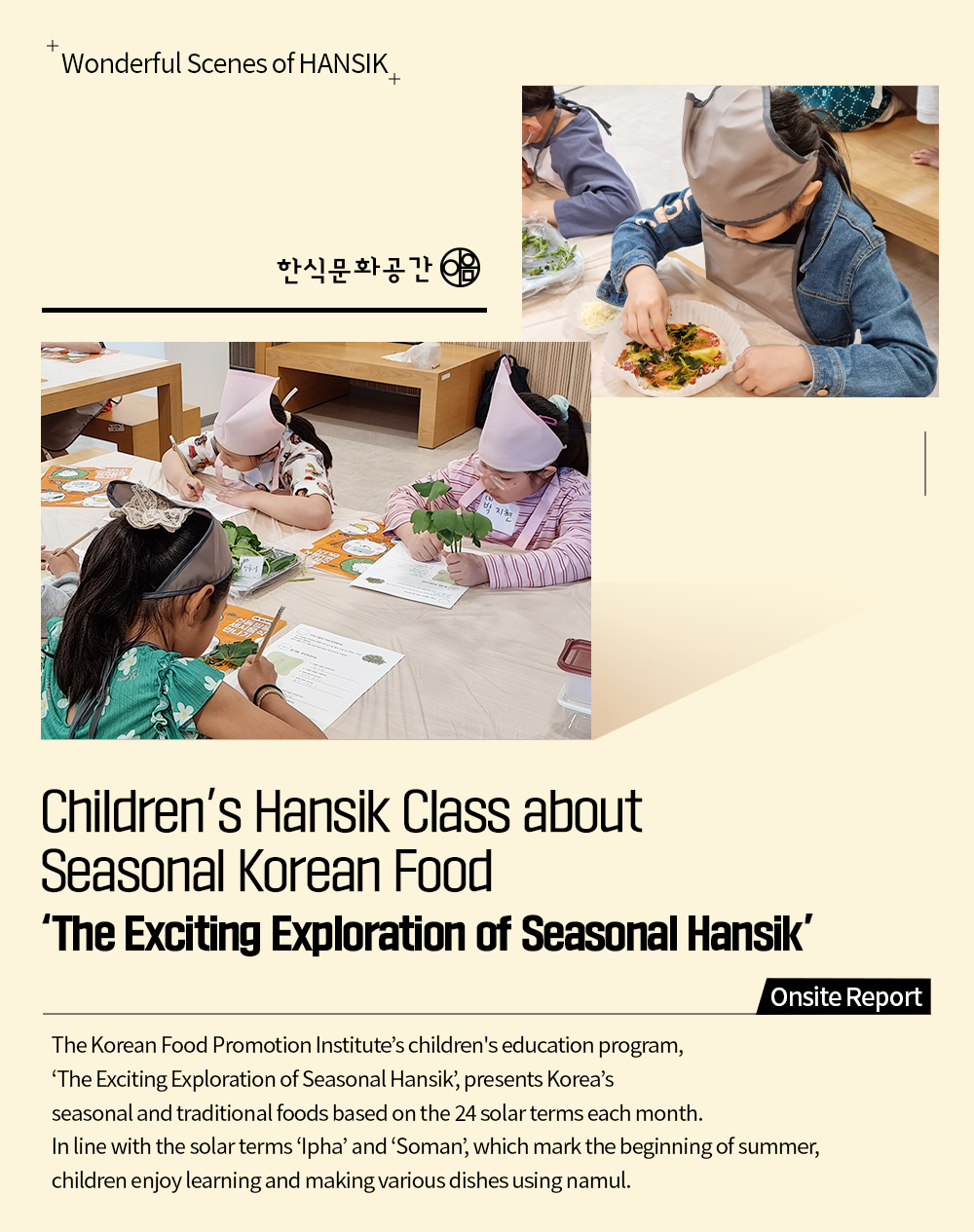
‘The Exciting Exploration of our Seasonal Hansik’ program, run by the Korean Food Promotion Institute, is an educational program designed to teach children about Hansik. Focusing on the 24 jeolgi (solar terms) traditionally observed in Korea, children learn about the seasonal and traditional foods. By exploring the foods and customs our ancestors enjoyed during each season, the program enhances understanding of traditional culture. It also allows children to experience seasonal ingredients firsthand, making it very popular.
On May 19, a class was held themed around ‘Ipha (beginning of summer)’ and ‘Soman (beginning of summer)’, the solar terms marking the beginning of summer. The children learned about various bomnamul (spring vegetable) that are good to eat during this time of plant growth, and then made a variety of dishes using these bomnamul. Hansik Magazine visited the site of the 'The Exciting Exploration of our Seasonal Hansik’ program, which was filled with the vibrant energy of the children.
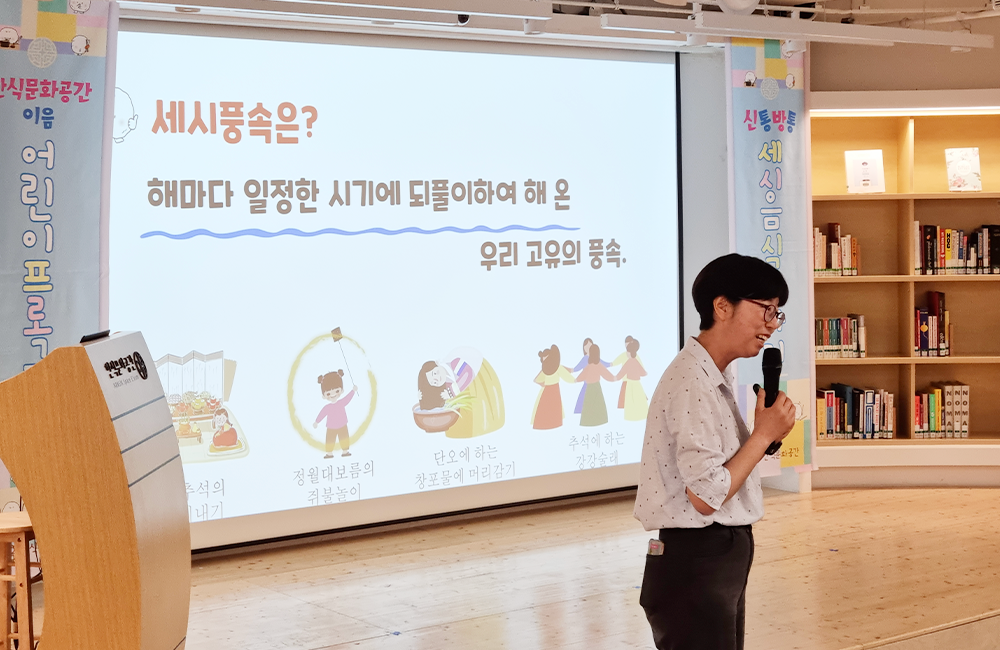
Learning the Wisdom of Our Ancestors through Seasonal Customs and Foods
The lecture hall at the Hansik Space E:eum was filled with the curious eyes of children. This program, which continues from last year, is known for its popularity, often being fully booked as soon as reservations open. Due to overwhelming demand, the number of sessions has been increased this year, allowing more children to participate.
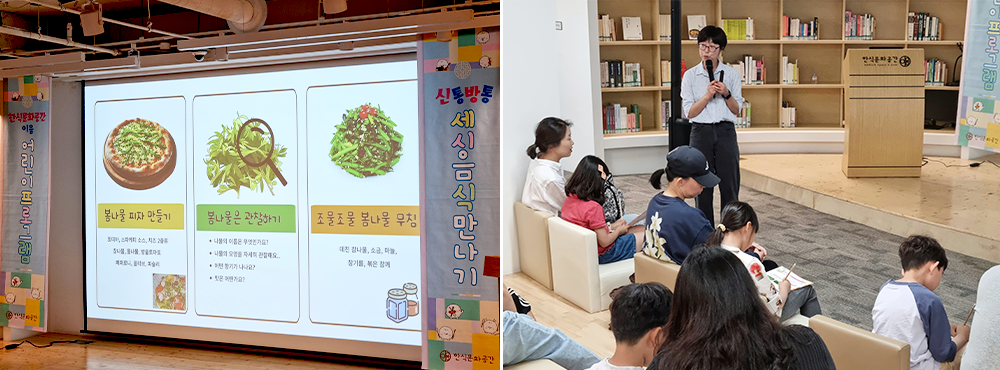
"Our ancestors gathered bomnamul from the mountains and fields or peeled tree bark and made seasonal dishes to survive the grain shortage in spring. Representative dishes include gondeurenamulbap (thistle rice), ssukbeomuli (mugwort rice cake), and songgitteok (pine bark rice cake). Today, these three dishes are popular as health foods."
The solar terms ‘Ipha’ and ‘Soman’, which represent May, signal the start of summer and the beginning of the ‘boritgogae (grain shortage in spring)’. ‘Boritgogae’ refers to the period around May and June in the solar calendar, when the previous autumn's grain stores were depleted, and the barley had not yet ripened, leading to hunger. The classroom buzzed with children who had tried gondeurenamulbap (thistle rice) and were curious about the taste of songgitteok (pine bark rice cake) made from the inner bark of pine trees.
During the ‘Bomnamul Quiz’, where children tried to identify bomnamul by their appearance, many eagerly raised their hands and shouted out answers. They learned about naengi (shepherd's purse) and dallae (wild chive) used in deonjangguk (soybean paste soup), dandelions and violets used for making namulmuchim (salad) or flower teas, and dureup (fastia shoots) known as the ‘king of namul’. The session was both educational and enjoyable as they explored the characteristics, benefits, and recipes of various namul.
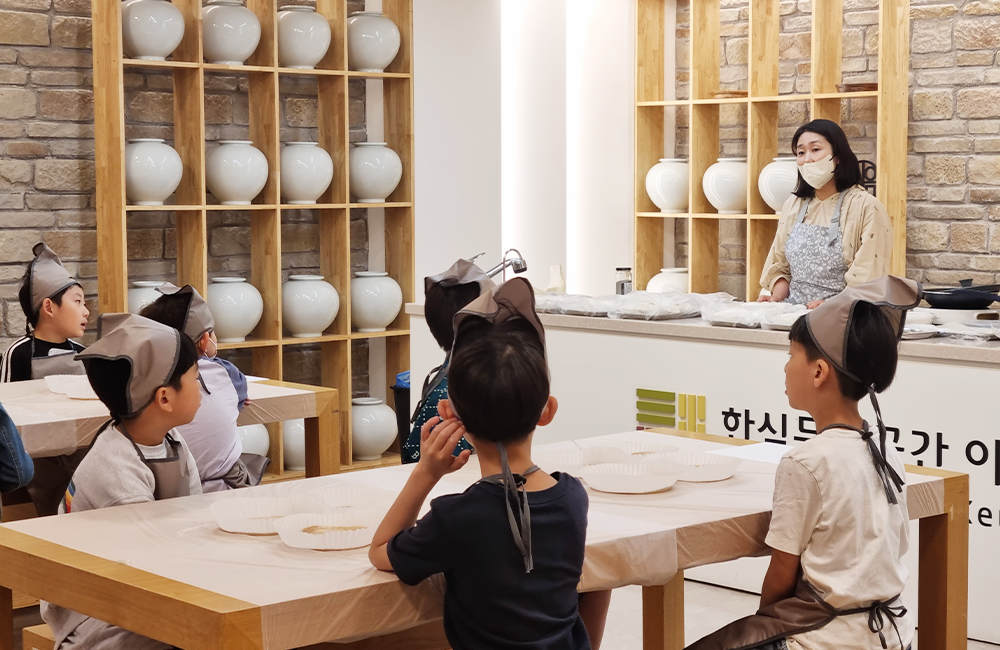
Making Namul Pizza that Kids Love
Now it was time to make some namul dishes. After putting on aprons and caps, the children moved to the E:eum Studio on the second floor, where tortillas were laid out at each station. What kind of dish can you make with namul and tortillas? This unique combination was the first recipe of the day: ‘Namul Pizza’.
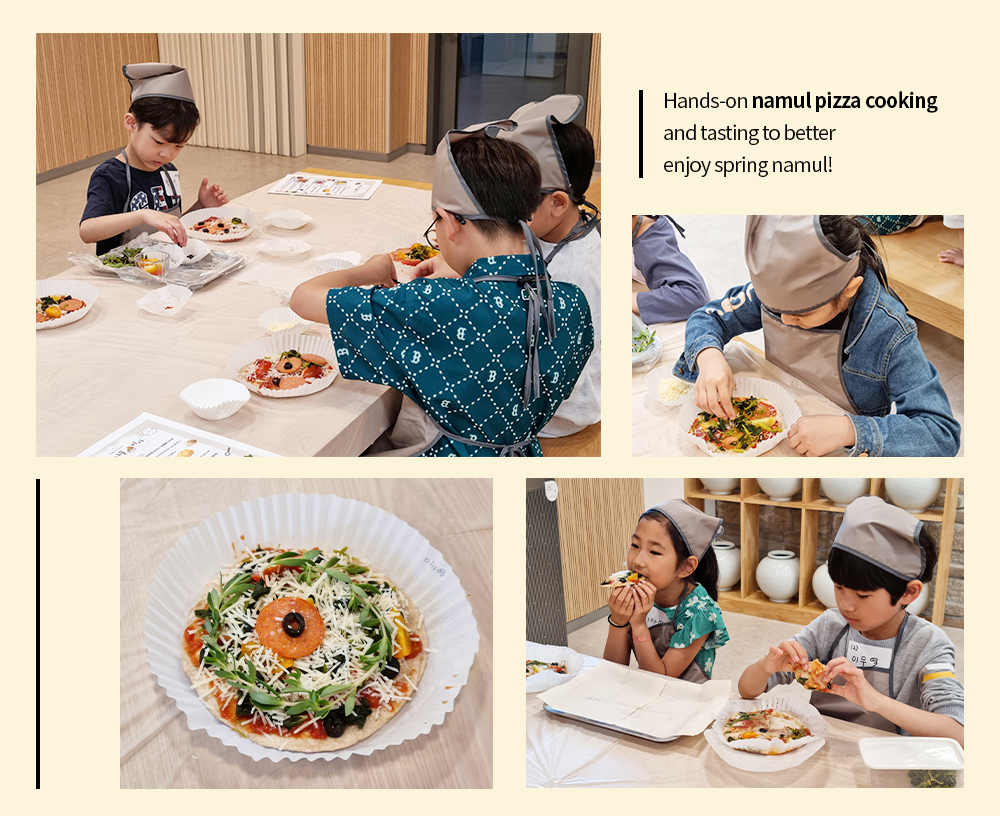
"The Best Pizza We Ever Tasted!"
To make namul pizza, children topped tortillas with cheese, tomato sauce, pepperoni, olives, cherry tomatoes, and a variety of namul. To enhance the texture and flavor, chamnamul (short-fruit pimpinella) was blanched, while dolnamul (stonecrop) was used fresh.
The children were fully engrossed in decorating their pizzas beautifully. One pizza, decorated with a circle of namul, particularly caught the attention of others. After about ten minutes of cooking in the frying pan, the studio was filled with the delicious aroma of freshly made pizza. The children eagerly tasted their hot creations and exclaimed, “The namul are so refreshing!" and "This is really delicious!" Through this namul pizza-making experience, the children learned to enjoy namul without hesitation and feel more connected to these healthy ingredients.
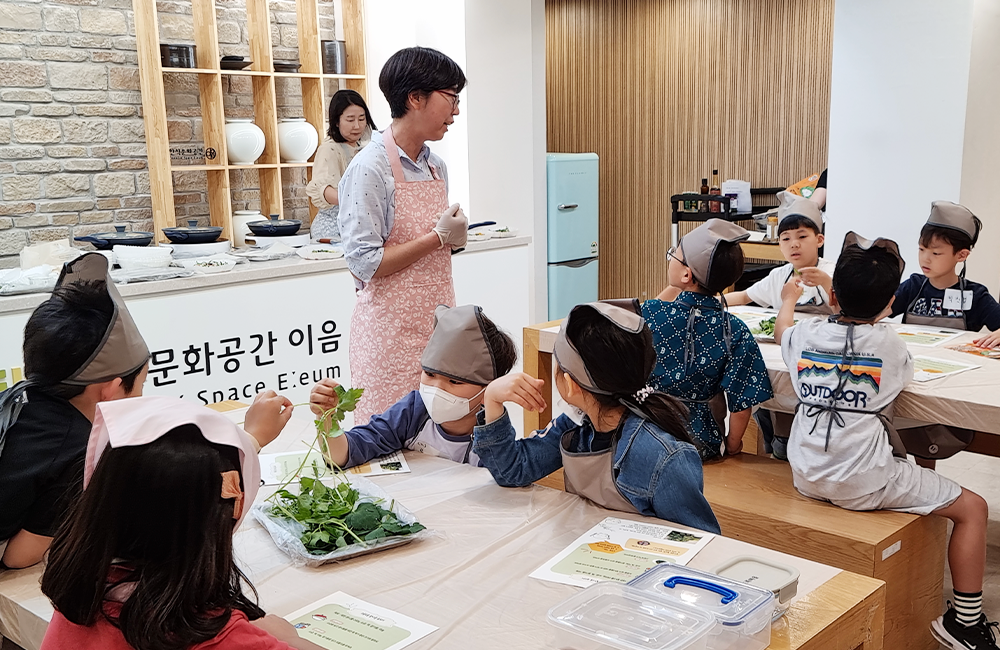
Observing Bomnamul Up Close
Next up was a program where children experienced three representative bomnamul (spring vegetable)—chamnamul (short-fruitpimpinella), dolnamul (stonecrop), and banpungnamul (siler divaricata)—using all their senses: sight, smell, taste, and touch. Instead of cooking them as usual, the children had the opportunity to observe these namul in their natural state, recording their aroma and appearances firsthand.
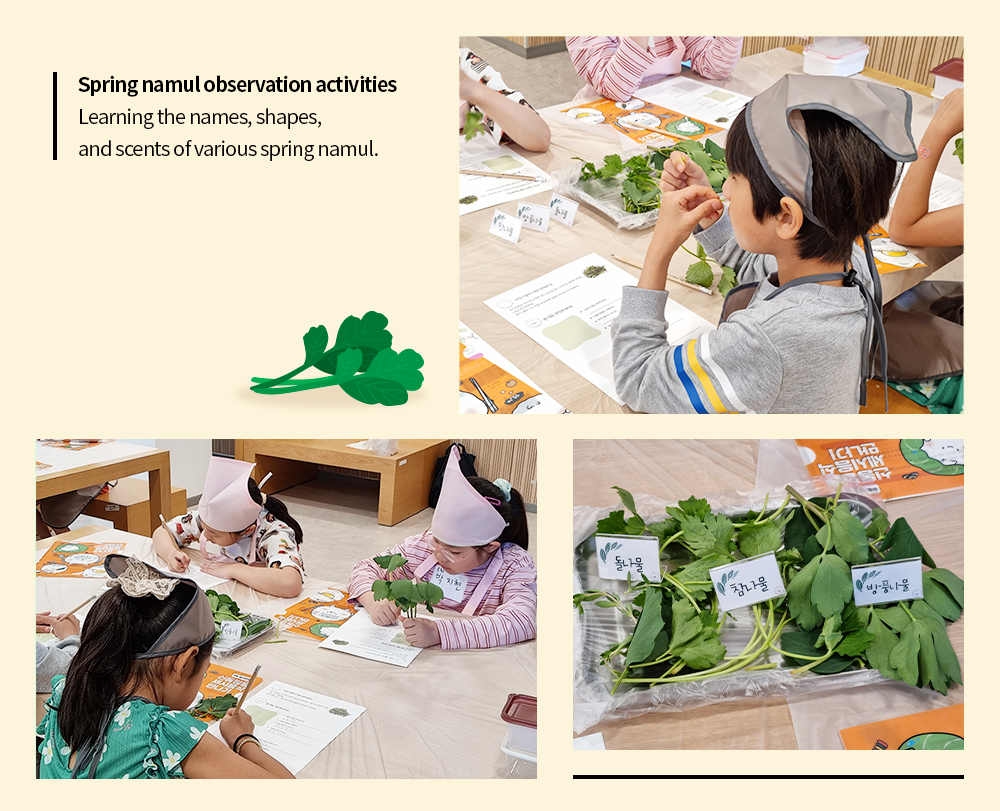
The expressions on the children who observed the shapes of leaves with their eyes and touched them with their hands were quite serious. Those who smelled the aroma identified that chamnamul had a refreshing scent, while bangpungnamul had a bitter smell, and their thoughts were shared with each other. While observing, they sketched each namul's appearance on their activity sheets, compiling their own namul guidebooks and cataloging the taste and fragrance of each specimen.
‘Jomuljomul’* Seasoning Bomnamul
For the final activity, children tried making the most common bomnamul dish, namulmuchim (salad). They seasoned pre-blanched chamnamul (short-fruit pimpinella) with salt, garlic, sesame oil, and other ingredients, mixing them together by hand until well combined. Sprinkling toasted sesame seeds on top of the nicely seasoned namul gave it an appetizing visual appeal. The completed chamnamulmuchim (short-fruit Pimpinella salad) was packed into a container brought from home, ready to be shared and enjoyed with family.
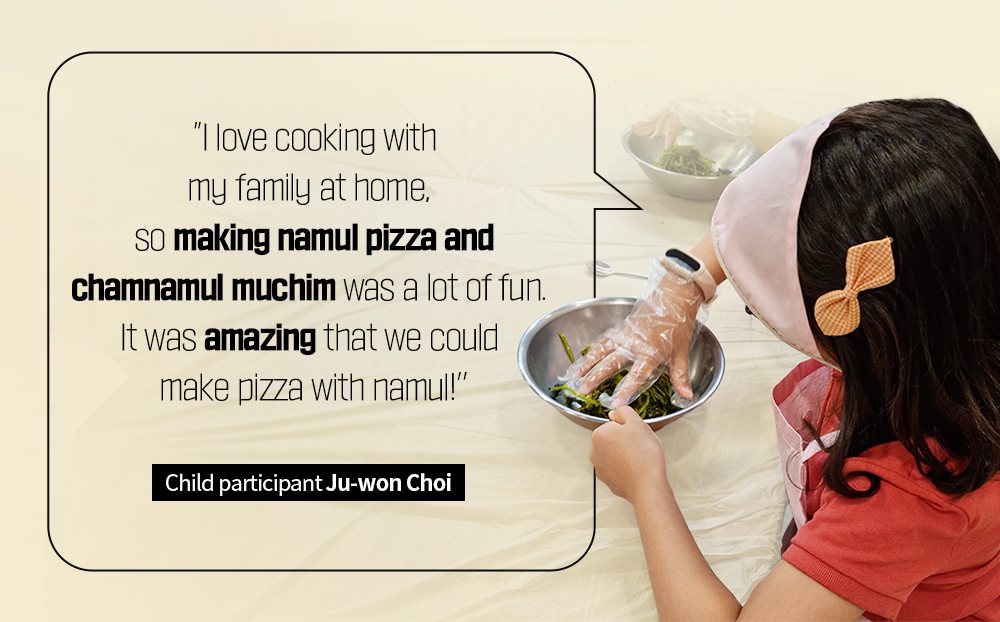
A parent who participated in the program with their child said, "Usually, children only know about traditional holidays like Lunar New Year and Chuseok, but it was great to learn about the traditonal sesi (the four seasons) and jeolgi (24 divisions of the solar year) through this class. It's a valuable program that seamlessly integrates theory with practical, hands-on experience."
The program, "The Exciting Exploration of our Seasonal Hansik" operates twice a month with themes focusing on seasonal and traditional foods. Participation can be applied for through the reservation page of the Hansik Space, E:eum (https://resv.hansik.or.kr/main/main.do).
* ‘Jomuljomul’ is a vivid term in Korean culinary culture that captures the action of seasoning namul with a gentle yet deliberate pressure. It's akin to pressing or massaging the seasoning into the namul to ensure thorough absorption. This technique not only coats the namul evenly but also enhances their flavor profile, resulting in a harmonious and well-balanced dish.










